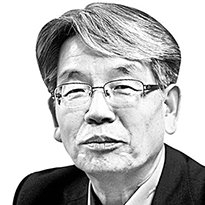Refuel brains to better respond to inaccuracies

The author is a history professor at Hankuk University of Foreign Studies.
The report of the National Museum of China in Beijing’s deliberate omission of two ancient Korean kingdoms from the chronology table of ancient Korean history in line with its history distortion by claiming sovereignty over ancient Korean state entities across Manchuria has caused uproar in South Korea. National museums of South Korea, Japan and China have been holding joint exhibits every two years for trilateral exchange and cooperation. To mark the 30th anniversary of the diplomatic relationship with South Korea and 50th year of normalization of ties with Japan, the Chinese national museum opened “Auspicious Metals from the Orient Ancient Bronzes of China, Korea, and Japan” from July 26.
The Korean national museum supplied 15 relics for the exhibit including several national treasures like the Bell of Cheonheungsa from the Goryeo Kingdom with a table of chronology of ancient Korean history. Its Chinese counterpart however removed the records of Goguryeo (37 B.C.-A.D. 668) and Balhae (A.D. 698-926). Amending a state material is an outright violation of international rules. The National Museum of Korea shares the liability for failing to prevent the mishap.
China has made a habit of distorting history for its indulgence. Even with Covid-19, Korean museum authorities should have checked the progress of the exhibit through the Korean embassy in Beijing. But China has betrayed trust under the state campaign to bring Goguryeo and Balhae under its history.
China has enraged South Koreans with the so-called Northeast Project, a state-funded historical research spearheaded by the Chinese Academy of Social Science from 2002 to 2007. The project was designed to provide the historical foundation for a unified state of multiple races. Since the founding of the Chinese republic in October 1949, Beijing has annexed many minority groups. Under the doctrine of Sinocentrism of one Han race and culture, minority ethnic groups should have been dealt with as independent history. China attempted to correct the doctrine by placing all entities born out of the Chinese territory as a part of the Chinese history under the new concept of a unified multi-ethnic state.
Until the 1980s, China admitted Goguryeo as a part of Korea in light of its relationship with North Korea. After North Korea faced a challenge to the Kim regime in 1990s, it included Goguryeo as part of Chinese history under the unified multi-ethnic rationale. It opened research institutes on Goguryeo with state sponsorship and carried out research. As long as Beijing keeps to the unified multi-ethnic narrative on national root, it will continue its claim over Gogruyeo.
After the North Project caused controversy in 2003, the Education Ministry of South Korea established a foundation on the research of Gogruyeo in early 2004 that since 2006 was rebranded as the Northeast Asia History Foundation. The foreign ministries of the two countries in August that year announced a joint statement on the issue. After diplomatic friction was resolved, social attention waned as well as government support.
Just two out of six to seven experts on Goguryeo remain at the foundation. The research center has lost 30 percent of its budget over the last 10 years. South Korea can hardly respond well to Chinese distortion with such poor infrastructure. The government and legislative must restore the foundation budget to refuel brains at the institute to respond better to Chinese actions.
The National Museum of Korea and the Cultural Heritage Administration should consider building a national museum on Goguryeo. Korea has sufficient relics uncovered around Mt. Acha and the Imjin river to build a museum with outdoor exhibit space on the ancient kingdom whose borders expanded to large parts of Manchuria and eastern and inner Mongolia. By employing IT technology, it could exhibit Goguryeo relics kept in North Korea and China. The museum can be the foundation to proudly claim Goguryeo as Korean history to the world.
The Northeast History Foundation, foreign and education ministries must keep close tabs on Chinese developments and build a strong network with the academy and media for prompt and effective responses. If the National Museum of Korea acted in close cooperation with the foreign ministry, the recent upset could have been avoided. Seoul must sternly demand Beijing to act as a responsible state. China should fulfill “diplomatic attitude based on equality and reciprocity” as cited in President Xi Jinping’s opening remark to the exhibition.










with the Korea JoongAng Daily
To write comments, please log in to one of the accounts.
Standards Board Policy (0/250자)